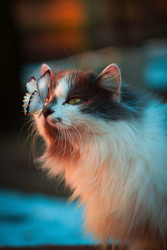Cat Fencing 101: Plastic vs. Metal
Cat Fencing Is An Essential Installation In Homes with Feline Pets
Felines are known for their restless, playful and swift nature, making them not only adorable but also troublesome in some cases. If you have a feline friend at home, then you may be concerned about its safety. Neighborhoods in urban areas are known for their road mishaps and other hazards, which can impact your furry friends. As such, an investment in pet fencing would be an extremely wise decision.
A cat fencing can help keep your cat contained within a designated area, such as a backyard. This can prevent your pets from wandering into areas where they might get lost or into trouble with other animals or people. By keeping cats contained, a cat fencing can help prevent cats from hunting and killing wildlife, which can have a negative impact on the environment. Moreover, cat fencing provides you the peace of mind as you can do away with worrying about your furry friend getting lost or into trouble.
Are you thinking of installing the best cat fence to keep your feline friend safe and secure? One of the most important considerations to keep in mind before making a purchase is the material. The best material for cat fencing depends on several factors, including the size of the area you need to enclose and the climbing and jumping ability of your cats. In this article, we give you an overview of two materials—plastic and metal—that are used for making cat fencing. Read on to know more.
Why choose plastic fencing for cats?
Also known as polypropylene fencing, plastic fencing makes for one of the best types of cat fencing.
1. Climb-resistant: Plastic like metal mesh fencing is flexible and climb-resistant. The slight waviness that the mesh exhibits indicates to a cat that it's not strong enough to hold its weight. Therefore, knowing its futility, your cat won’t attempt to challenge the fence. Brave felines who try to climb a plastic fence quickly realize their mistake and jump down. If you are looking for plastic cat fencing, our free standing outdoor cat kits and fence extenders that come with plastic mesh would be your ideal bet.
2. Durable and low-maintenance: Plastic fencing for cats is weather-resistant and do not rot, warp, or fade over time, making it a long-lasting option. With little to no maintenance, you can spend more time with your feline outside without worry.
3. Great visual appeal: Plastic cat fencing can be a very attractive installation in your home—something that blends into the environment, preserving your backyard view. With near invisibility at around 20 feet away, you’ll hardly even know it’s there!
Overall, plastic fencing is a versatile, low-maintenance, and safe option for cat owners who want to provide their pets with a secure outdoor environment. However, it's important to make sure that the fence is tall enough and securely anchored to the ground to prevent cats from jumping over it or escaping.
Why choose metal fencing for cats?
While we don't recommend metal fence mesh for a full fence system, we do recommend it for free-standing cat containment. A great option for you would be our fully enclosed catio or a DIY wooden catio with metal fence inlays. Anything with a roof that will prevent the cats from climbing and escaping will do great with metal fencing.
Nonetheless, metal fencing, such as our welded wire or steel hex, can be a good choice for cat owners for several reasons:
1. Durability: Metal fencing is strong and durable, making it a good option for pet owners who want to create a long-lasting boundary for their cats.
2. Security: Metal fencing is difficult to climb or chew through, providing a secure and safe environment for cats.
3. Low Maintenance: Our metal fence is coated in Black PVC that UV-resistant, making it weather resistant and long-lasting.
4. Attractive: Metal fencing can add a decorative touch to your yard, making it an attractive option for homeowners who want to create an inviting outdoor space for their cats.
5. Customizable: The height and design of metal fencing can be customized to fit your specific needs. So, they are a versatile option for pet owners who want to create a tailored environment for their cats.
Metal fencing can be a good option for cat owners who want to create a durable and secure boundary for their pets. But it's important to consider all the factors before deciding.
This finally brings us to the key question of this discussion, which is……
What's the best fencing for cats overall?
We recommend combining plastic and metal fencing options. Plastic will deter cats from climbing but can be vulnerable to chewing. A metal cat fence on the bottom of the plastic mesh will prevent cats or other animals from creating holes in the bottom of the fence that could be used for escape.
Conclusion
Ultimately, the choice between plastic and metal fencing will depend on your specific needs and the environment in which you live. It's important to consider the size of the area you need to enclose, the type of terrain, and the climbing and jumping ability of your cats, before deciding.
Since the installation of the best cat fence involves money and it is a long-term investment, you should consider getting in touch with experts at Easy Pet Fence. Explore our cat fence containment fences to find the right cat fence solution for your specific needs. Feel free to use our customer support chat or give us a call to clarify installation-related questions.

